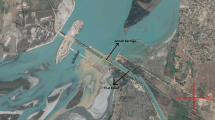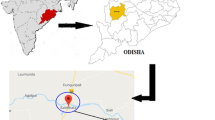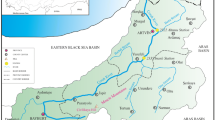Abstract
This study aims at the development of an artificial neural network-based model for the estimation of weekly sediment load at a catchment located in northern part of Pakistan. The adopted methodology has been based upon antecedent sediment conditions, discharge, and temperature information. Model input and data length selection was carried out using a novel mathematical tool, Gamma test. Model training was carried out by using three popular algorithms namely Broyden-Fletcher-Goldfarb-Shanno (BFGS), back propagation (BP), and local linear regression (LLR) using forward selection of input variables. Evaluation of the best model was carried out on the basis of basic statistical parameters namely R-square, root mean squared error (RMSE), and mean biased error (MBE). Results indicated that BFGS-based ANN model outperformed all other models with significantly low values of RMSE and MBE. A strong correlation was also found between the observed and estimated sediment load values for the same model as the value of Nash-Sutcliffe model efficiency coefficient (R-square) was found to be quite high as well.







Similar content being viewed by others
References
Agalbjorn, S., Koncar, N., & Jones, A. J. (1997). A note on the gamma test. Neural Computing and Applications., 5, 131–133.
Agarwal, A., Mishra, S. K., Ran, S., & Singh, J. K. (2006). Simulation of runoff and sediment yield using artificial neural network. Biosystems Engineering, 94(4), 597–613.
Akrasi, S. A.., & Ansa-Asare, O. D. (2003) Assessing sediment and nutrient transport in the Pra basin of Ghana. West African Journal of Applied Ecology, 13.
Alam, U. Z. (1998). Water rationality: mediating the Indus waters treaty. University of Durham: Unpublished thesis.
Ali, K. F., & De Boer, D. H. (2003). Construction of sediment budgets in large-scale drainage basins: the case of the upper Indus river. International Association of Hydrological Sciences Publication, 279, 206–215.
Alizdeh, M. J., Joneyd, P. M., Motahhari, M., Ejlali, F., & Kiani, H. (2015). A wavelet ANFIS model to estimate sedimentation in dam reservoir. International Journal of Computer Applications, 114(9), 19–25.
Alp, M., & Cigizoglu, H. K. (2005). Suspended sediment load simulation by two artificial neural network methods using hydrometeorological data. Environmental Modelling & Software, 22(1), 2–13.
Azamathulla, H. M., Ab, G. A., Chang, C. K., Abu, H. Z., & Zakaria, N. A. (2010). Machine learning approach to predict sediment load—a case study. Clean-Soil Air Water, 38(10), 969–976.
Bhattacharya, B., Price, R. K., & Solomatine, D. P. (2007). Machine learning approach to modelling sediment transport. Journal of Hyraulic Engineering, 133(4), 440–450.
Cigizoglu, H. K. (2004). Estimation and forecasting of daily suspended sediment data by multi-layer perceptrons. Advances in Water Resources, 27, 185–195.
Cobaner, M., Unal, B., & Kisi, O. (2009). Suspended sediment concentration estimation by an adaptive neuro-fuzzy and neural network approaches using hydrometeorological data. Journal of Hydrology, 367, 52–61.
Environmental Water Resources Institute, U.W.R.R.C., Gross Solids Technical Committee. (2007). ASCE guideline for monitoring storm water gross solids.
Evans, D. (2002). Database searches for qualitative research. Journal of the Medical Library Association, 90(3), 290–293.
Fine T. L. (1999) “Feedforward neural network methodology” (statistics for engineering and information science). 340 pp. Springer
Fletcher, R. (1987). Practical methods of optimization. New York, N.Y.: Wiley.
Tayfur, G. (2002). Artificial neural networks for sheet sediment transport. Hydrological Sciences Journal, 47(6), 879–892.
Habib-ur-Rehman, M. (2001). Regional scale soil erosion and sediment transport modeling. Ph.D. Thesis, University of Tokyo, pp. 183.
Hassan, M., Shamim, M. A., Hashmi, H. N., Ashiq, S. Z., Ahmed, I., Pasha, G. A., Naeem, U. A., Ghumman, A. R., & Han, D. (2014). Predicting streamflows to a multipurpose reservoir using artificial neural networks and regression techniques. Earth Science Informatics, 8(2), 337–352.
Haykin, S. (1999). Neural networks: a comprehensive foundation (2nd ed., ). USA: Prentice-Hall.
Hays, D., & Wu, P. (2001). “Simple approach to TSS source strength estimates” proceedings, 21st annual meeting of the western dredging association (WEDA XXI) and 33rd annual Texas A&M dredging seminar. Texas: Houston.
Heng, S., & Suetsugi, T. (2013). Using artificial neural network to estimate sediment load in ungauged catchments of the tonle sap river basin, Cambodia. Journal of Water Resource and Protection, 5, 111–123.
Jain, A., Sudheer, K. P., & Srinivasulu, S. (2004). Identification of physical processes inherent in artificial neural network rainfall runoff models. Hydrological Processes, 18, 571–581.
Jason W. Osborne, (2010) Improving your data transformations; applying the box-Cox transformation Practical Assessment, Research & Evaluation 15(12)
Jie L.C., Yu S.T., (2011) “Suspended sediment load estimate using support vector machines in Kaoping River basin” 978–1–61284–459–6/11 2011 IEEE
Jones, A. J. (2004). New tools in non-linear modelling and prediction. Computational Management Science, 1, 109–149.
Kisi, Ö. (2004a). River flow modeling using artificial neural networks. Journal of Hydrologic Engineering, 9(1), 60–63.
Kisi, O. (2004b). Multi-layer perceptrons with levenberg–Marquardt training algorithm for suspended sediment concentration prediction and estimation. Hydrological Sciences Journal, 49(6), 1025–1040.
Kisi, O. (2005). Suspended sediment estimation using neuro-fuzzy and neural network approaches. Hydrological Sciences Journal, 50(4), 683–696.
Kisi, O., Yuksel, I., & Dogan, E. (2008). Modeling daily suspended sediment of rivers in Turkey using several data-driven techniques. Hydrological Sciences Journal, 53(6), 1270–1285.
Kux, D. (2006). India Pakistan negotiations: is past still prologue? In Perspective Series. Washington, DC: United States Institute of Peace.
Lane, L. J., & Nicholas, M. H. (1997). A hydrologic method for sediment transport and yield. In S. Y. Wang, E. J. J. Langendeon, & F. D. Shields, Jr. (Eds.), Management of Landscapes Disturbed by Channel Incision (pp. 365–370). University of Mississippi, Oxford, MS: Center for Comp. Hydrosci. And Eng.
Lin, B., & Namin, M. M. (2005). Modelling suspended sediment transport using an integrated numerical and ANNs model. Journal of Hydraulic Research, 43(3), 302–310.
Lekkas, D. F., Imrie, C. E., & Lees, M. J. (2001). Improved non-linear transfer function and neural network methods of flow routing for real-time forecasting. Journal of Hydroinformatics, 3, 153–164.
Maier, H. R., & Dandy, G. C. (1998). Understanding the behaviour and optimising the performance of back-propagation neural networks: an empirical study. Environmental Modelling and Software, 13, 179–191.
Minsky, M., & Papert, S. (1969). Perceptrons. Cambridge, MA: MIT Press.
McCulloch, W. S., & Pitts, W. H. (1943). A logical calculus of the ideas immanent in nervous activity. Bulletin of Mathematical Biophysics, 7, 115–133. Reprinted in McCulloch 1964, pp. 16–39.
Mustafa, M. R., Isa, M. H., & Rezaur, R. B. (2011). Comparison of artificial neural network for prediction of suspended sediment discharge in river—a case study in Malaysia. World Academy of Science, Engineering and Technology, 81, 372–376.
Nagy, H. M., Watanabe, K., & Hirano, M. (2002). Prediction of sediment load concentration in rivers using artificial neural network model. Journal of Hydraulic Engineering (ASCE), 128(6), 588–595.
Nakai O. (1978) “Turbidity generated by dredging projects, management of bottom sediments containing toxic substances” Proceedings of the third United States-Japan experts meeting, EPA-600/3–78–084, 1–47
Nourani, V. (2009). “Using artificial neural networks (ANNs) for sediment load forecasting of talkherood river mouth”. Journal of Urban and Environmental Engineering, 3(1), 1–6.
Nourani, V., Parhizkar, M., Vousoughi, F. D., & Amini, B. (2014). Capability of artificial neural network for detecting hysteresis phenomenon involved in hydrological processes. Journal of Hydrologic Engineering, 19, 896–906.
Olyaie, E., Banejad, H., Chau, K. W., & Melesse, A. M. (2015). “A comparison of various artificial intelligence approaches performance for estimating suspended sediment load of river systems: a case study in United States”. Environmental Monitoring and Assessment, 187(4), 189.
Painter, D. J. (1981). Steeplands erosion processes and their assessment. In T. R. H. Davis, & A. J. Pearce (Eds.), Erosion and sediment stransport in Pacific Rim steeplands. IAHS_AISH publ. 132 (pp. 2–20). Washington, DC: International Association of Hydrological Sciences.
Partal, T., & Cigizoglu, H. K. (2008). Estimation and forecasting of daily suspended sediment data using wavelet-neural networks. Journal of Hydrology, 358, 317–331.
Pennekamp, J. G. S., Epskamp, R. J. C., Rosenbrand, W. F., Mullie, A., Wessel, G. L., Arts, T., & Deibel, I. K. (1996). Turbidity caused by dredging; viewed in perspective. Terra et Aqua, 64, 10–17.
Rajaee, T., Mirbagheri, S. A., Zounemat-kermani, M., & Nourani, V. (2009). Daily suspended sediment concentration simulation using ANN and neuro-fuzzy models. The Science of the Total Environment, 407, 4916–4927.
Remesan, R., Shamim, M. A., & Han, D. (2008). Model data selection using gamma test for daily solar radiation estimation. Hydrological Processes, 22, 4301–4309.
Remesan, R., Shamim, M. A., Han, D., & Mathew, J. (2009). Runoff prediction using an integrated hybrid modelling scheme. Journal of Hydrology, 372(1), 48–60.
Remesan, R., Shamim, M. A., Ahmadi, A., & Han, D. (2010). Effect of data time interval on real-time flood forecating. Journal of Hydroinformatics, 12(4), 396–407.
Roesner, L., Qian, Y., Criswell, M., Stromberger, M., & Klein, S. (2006). Long-term effects of landscape irrigation using household graywater– literature review and synthesis. Water Environment Research Foundation: Resource Document.
Rosenblatt, F. (1962). Principles of neurodynamics; perceptrons and the theory of brain mechanisms. Spartan Books: Washington.
Shamim, M. A., Hassan, M., Ahmad, S., & Zeeshan, M. (2015). A comparison of artificial neural networks (ANN) and local linear regression (LLR) techniques for predicting monthly reservoir levels. Journal of Korean Society for Civil Engineering(in Press). doi:10.1007/s12205-015-0298-z.
Shamim, M. A., Bray, M., Remesan, R., & Han, D. (2014). A hybrid modelling approach for assessing solar radiation. Theoretical and Applied Climatology(in Press). doi:10.1007/s00704-014-1301-1.
Shamim, M. A., Remesan, R., Han, D., & Ghumman, A. R. (2010). Solar radiation estimations in ungauged catchments. Proceedings of the ICE. Water Management, 163(7), 349–359.
Shamim, M. A., Ghumman, A. R., & Ghani, U. (2004). Forecasting groundwater contamination using artificial neural networks. In International conference on water resources and arid environments, December 2004. Riyadh: Saudi Arabia: King Saud University.
Shamseldin, A. Y. (2010). Artificial neural network model for river flow forecasting in a developing country. Journal of Hydroinformatics, 12, 22–35.
Stefánsson, A., Končar, N., & Jones, A. J. (1997). A note on the gamma test. Neural Computing Applications, 5, 131–133.
Tayfur, G., & Guldal, V. (2006). Artificial neural networks for estimating daily total suspended sediment in natural streams. Nordic Hydrology, 37, 69–79.
Weaver, W., & Madej, M. A. (1981). Erosion control techniques used in Redwood National Park, Northern California 1978-1979. In Proceedings of a Symposium on Erosion and Sediment Transport in Pacific Rim Steeplands, Christchurch, New Zealand (pp. 640–645). Washington, DC: International Association of Hydrological Sciences Publication Number 132.
Zhu, Y. M., Lu, X. X., & Zhou, Y. (2007). “Suspended sediment flux modeling with artificial neural network: an example of the Longchuanjiang River in the Upper Yangtze Catchment. China” Geomorphology, 84, 111–125.
Author information
Authors and Affiliations
Corresponding author
Rights and permissions
About this article
Cite this article
Hassan, M., Ali Shamim, M., Sikandar, A. et al. Development of sediment load estimation models by using artificial neural networking techniques. Environ Monit Assess 187, 686 (2015). https://doi.org/10.1007/s10661-015-4866-y
Received:
Accepted:
Published:
DOI: https://doi.org/10.1007/s10661-015-4866-y




